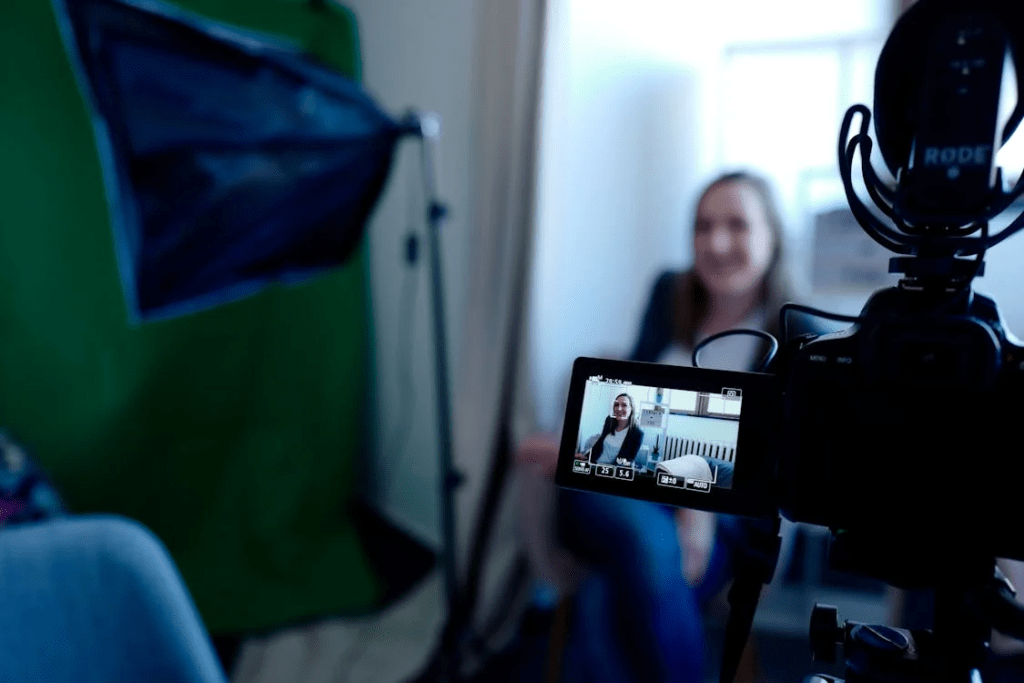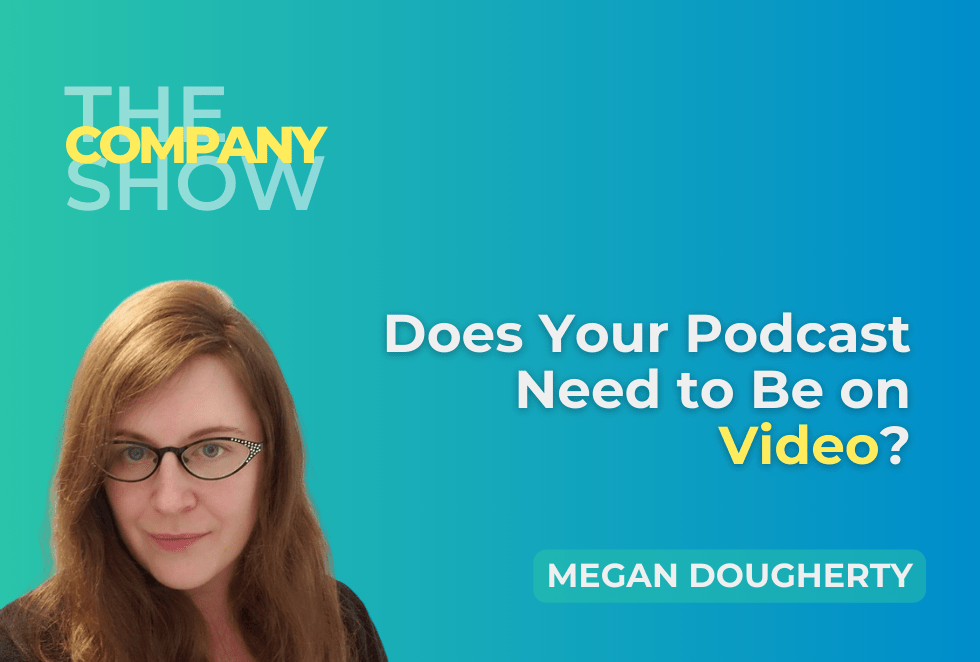Let me tell you a little story.
Back in the halcyon days of 2019, I had a strong belief—I believed that video was video and podcasts were podcasts, and ne’er between should meet.
Podcasts certainly did not belong on YouTube. I would have died on that hill.
Then, in 2020, I conducted the first State of Business Podcasting Report and learned that the vast majority of the top 100 podcasts had YouTube channels, and most of them put episodes there. Now we make MP4 versions of all the podcasts we produce so they can go on YouTube.
When I’m wrong, I’m wrong. It’s become one of my best anecdotes, though, so there’s a win.
I have a whole lot of information for you today about audio vs. video podcasts and how to make that choice for your business. Listen below or continue reading the blog post!
Tune in to the full episode to learn about:
- The current state of video podcasting
- Pros and cons of video podcasts
- How to make the choice between audio and video
Don’t forget to join us for our free monthly strategy calls on the third Thursday of every month!
Before we get into audio vs. video, here’s an update:

I am delighted to be able to report that Podcasting for Business, the book, is currently in editing and set for release later this year.
It feels pretty good. This is a project a long time in the making, and I feel confident that we’re looking at podcast value attribution in an entirely new way that will change the game in how you design, produce and track the outcome of your company’s podcast.
The official launch date for the book is Tuesday September 10th, and we have some very exciting things planned to celebrate it.
We’ll have sample chapters, workshops, abundant bonus resources and privileged access to this year’s Podcasting For Business Conference.
We’ll also have an entire behind-the-scenes documentary-style podcast I’ve created with Amy Collette, the book coach I’ve been working with to get this draft from my brain and our content archive. That will be coming out next month—stay tuned!
Find out what’s coming and get involved here.
I really can’t wait to share it with you. I mean that literally—I can’t.
That’s why I’m sharing a part of one section with you today on this episode, all about making the choice between audio-first and video-first shows.
The Rise of Video Podcasting
In the last few years, video podcasting has gotten even more popular.
In the State of Business Podcasting Report, in 2023 we found that 83% of the Top 100 business podcasts had YouTube channels, and nearly all (94%) put full episodes on them—60% of which were live-action video.
The other types being still image with audio overlay, audiogram style with animated .wav signs or a mix of multiple formats). 43% of the top 100 were what we call video-first shows, designed to be seen as much or more than just listened to.
It’s tempting to think that you need to be creating a video podcast if you wat to get any traction at all—that might send you screaming for the hills.
But don’t worry, video in podcasting is still optional.
Anecdotally, we’re seeing the stats play out a little differently. Most of the shows that we produce for business owners that are fulfilling different business functions aren’t seeing huge traction on YouTube—the vast majority of plays happen on the traditional podcast platforms.
There are absolutely more podcasts that are created using video but from what I have been able to determine, the data around video in podcasting is somewhat skewed by a handful of truly massive video podcast channels in each industry.
These are shows, often in a talk show format that are drawing millions of views for each episode. They are almost all run as businesses themselves, or conversion strategies, and the audio versions are an afterthought.
Since they are delivered by RSS as well as on YouTube, they are making it seem like video is more universally critical than we see ‘on the ground’ in production for businesses.
This isn’t to say you shouldn’t upload your podcast to YouTube (you should), but it does raise the question of whether or not you should go to the considerable trouble and expense of having a live action version of your episodes produced.
There are good arguments on both sides.
Why You Should Make A Video Podcast
Better Discoverability.
YouTube is huge, and it’s search functionality is better than any audio-only podcast platform going.
They have a discoverability engine and an algorithm designed to show people content that will interest them and having your content in a live action format makes it much more likely that your episodes will be put into that system.
Video Converts and Connects better than Audio.*
I’ll say this for video, adding another sense, the visuals to your content makes it easier for people to connect with you.
Audio creates a deep and intimate connection, but video can make the process faster. Video also has higher conversion potential than audio. When people listen to podcasts, they’re usually also doing something else—walking cooking, driving, working out.
It’s not easy for them to click a link – they have to remember to do it later, which they usually don’t. A video that someone is watching means they can immediately take action on what you want them to do.
If your podcast goals are directly related to people consuming your content and taking action because of it, like for affiliate sales, product sales and monthly recurring revenue, that strengthens the case for video.
*If your production quality and performance are both high. If they aren’t you’re as likely to turn people away as pull them in.
Why You Shouldn’t Make a Video Podcast

Recording Complexity.
Video is considerably more difficult to record than audio.
When you record audio you have to make sure you have a good mic, you’re using it correctly, and your environment isn’t too noisy and echoey.
To record video you need to do all of that plus make sure your lighting is right, your clothes, hair and makeup present what you want them to. Same goes for your guests, who may not be comfortable on video.
There can be a lot more friction getting someone to agree to be on video than just have the audio recorded.
More Time and Money.
Video takes longer to produce and costs more than audio.
Like recording video content, editing video content requires different skills and processes than audio-only.
While it can give you a lot of flexibility in terms of adding elements to your show, like slides, overlays etc., this is highly skilled work that takes time to get out the door.
The costs can be double, triple or more than an audio-only show but this could all be worth it for your business!
It might be important to you to create the most highly polished, impressive content for your show possible. The benefits of search and discoverability or an existing video audience might make the extra complexity and expense negligible.
It call comes down to what your business goals, and the current resources you have to work with, are.
Making the Choice
High level, you need to answer the question: Are the benefits of video podcasting (better discoverability, more conversion/connection) worth the problems (more difficult and expensive)?
That is going to depend on your business and your goals.
All things being equal, I recommend new podcasters start with an audio only or audio-first show. Getting good at making audio is hard and takes time. Adding all of the extra elements of video right at the outset is a lot and is often more than a business really needs.
If you’re an experienced podcaster and want to add polish and more reach to your show, then start experimenting with video!
You might want to start with a video season or series before committing to video forever to make sure you like it, can manage all elements of the process and are creating content in a way your listeners, clients, customers and community likes.
For the rest, you’re going to have to wait for the book, which will include action steps and decision making criteria for if you’re staring a new show, or refining and updating an existing one.
If you’re interested in leveraging a podcast more effectively in your business head over here and join the waitlist for the book and all of the launch bonuses!
Next Week on The Company Show
.png)
Next week I’ve got a fascinating conversation with Dr. Brigitte Bojkowszky, the creator of Bridget Brands, who is a company and personal brand identity strategist with over 23 years of experience in teaching global marketing management and branding at universities worldwide.
I learned so much from the conversation, and I’m sure you will to, so make sure you’re subscribed on your favorite podcast player to not miss a thing!
Need A Podcast?
The Company Show was made possible by the team at One Stone Creative.
If you know a business owner that you think should have a podcast, do us a favor and send them to podcastingforbusiness.com!
Key Quotes
“Getting good at making audio is hard and takes time. Adding all of the extra elements of video right at the outset is a lot and is often more than a business really needs.” – Megan Dougherty
Resources
One Stone Creative | LinkedIn | Twitter | Facebook | Instagram
Make sure to check out our free Monthly Strategy Calls!
Podcasting for Business Conference 2023 Recordings
Learn about what other business podcasters are doing:
Related:
- The Video Advantage for SEO with Atiba De Souza
- Should Company Podcasts be Company Vlogs? with Chrish Weiher
- Podcasting for Business on YouTube with Angela Hollowell
PFBCon 2023 Recordings
Whether you’re a solopreneur, manager of a department, principal at a firm, or a non-fiction author ready to expand into audio, the Podcasting for Business Conference will help you leverage a podcast to meet your business objectives.
Missed PFBCon 2023? Check out the recordings!

